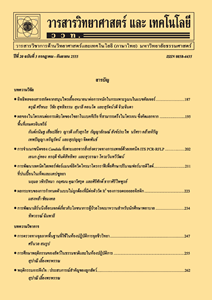ฤทธิ์ต้านจุลินทรีย์ ต้านอนุมูลอิสระ และยับยั้งเอนไซม์แอลฟากลูโคซิเดสของสารสกัดหยาบจากผลของบาร์บาโดสเชอร์รี (Malpighia glabra)
Main Article Content
Abstract
This research aims to evaluate the antimicrobial, antioxidant and anti-alpha-glucosidase activities of crude extracts from Malpighia glabra fruits. The fruits were extracted with hexane, dichloromethane and methanol. Three crude extracts were evaluated for their antimicrobial, antioxidant and alpha-glucosidase inhibitory activities by using a colorimetric broth microdilution test, DPPH free radical scavenging assay and alpha-glucosidase inhibitory activity assay, respectively. Six pathogenic bacteria, Staphylococcus aureus, methicillin resistant Staphylococcus aureus, Escherichia coli, Pseudomonas aeruginosa, Candida albicans and Cryptococcus neoformans, were used in the antimicrobial test. Hexane extract was the most active against C. albicans with MIC and MFC of 8 of 16 µg/mL, respectively. The extract killed target microorganism by destroying cell surface. Dichloromethane extract had the strongest anti-alpha-glucosidase activity with IC50 value of 1.12 mg/mL. On the other hand, methanol extract had the strongest antioxidant activity with EC50 value of 1.15 mg/mL. These results showed that crude extracts from the M. glabra fruits are interesting because they are a good source of many bioactive compounds.
Article Details
References
[2] Deerochanawong, C. and Ferrario, A., 2013, Diabetes management in Thailand: A literature review of the burden, costs, and outcomes, Global Health 9: 1-18.
[3] Dusman, E., Ferreira, M.F.S., Berti, A.P., Mariucci, R.G., Mantovani, M.S. and Vicentini, V.E.P. 2012, Investigation of cytotoxic and mutagenic effects of Malpighia glabra L. (barbados cherry) fruit pulp and vitamin C on plant and animal test systems, Ciênc. Tecnol. Aliment. Campinas. 32: 405-411.
[4] Nascimento, E.M.M., Rodrigues, F.F.G., Costa, W.D., Teixeira, R.N.P., Aline, N.P.T., Erlanio, A.B., Fabiola, O.S., Rodrigues, F.F.G., Coutinho, H.D.M. and Costa, J.G.M., 2018, HPLC and in vitro evaluation of antioxidant properties of fruit from Malpighia glabra (Malpighiaceae) at different stages of maturation, Food. Chem. Toxicol. 119: 457-463.
[5] Supaphon, P., Phongpaichit, S., Rukachaisirikul, V. and Sakayaroj, J., 2013, Antimicrobial potential of endophytic fungi derived from three seagrasses (Cymodocea serrulata, Halophila ovalis and Thalassia hemprichii) from Thailand, PLoS ONE 8(8): e72520.
[6] Premianu, N. and Jaynthy, C., 2014, Antioxidant activity of endophytic fungi isolated from Lannea coromendalica, Int. J. Res. Pham. Sci. 5: 304-308.
[7] Sagar, S.B., Padmavathi, A.T.V.N., Kavitha, C. and Durgarani, T.S.A.V., 2013, Estimation of physico-chemical properties, nutrient composition and antioxidant activity of Acerola Malpighia emarginata DC, J. Res. Angrau. 41: 97-101.
[8] Johnson, P.D., 2003, Acerola (Malpighia glabra L., M. punicifolia L., M. emarginata D.C.): Agriculture, production and nutrition, plants in human health and nutrition policy, World Rev. Nutr. Diet 91: 67-75.
[9] Nunes, R.S., Kahl, V.F.S., Sarmento, M.S., Richter, M.F., Costa-Lotufo, L.V., Rodrigues, F.A.R., Abin-Carriquiry, J.A., Martinez, M.M., Ferronatto, S., Ferraz, A.B.F. and Silva, J., 2011, Antigenotoxicity and antioxidant activity of acerola fruit (Malpighia glabra L.) at two stage of ripeness, Plant Foods Hum. Nutri. 66: 129-135.
[10] Schmourlo, G., de Morais-Filho, Z.B., de Oliveira, D.B., Costa, S.S., Mendonça-Filho, R.R., Alviano, C.S. and Miranda, A.L.P., 2007, antioxidant and antimicrobial activity of edible plants and their potential as nutriceuticals, Acta. Hort. 765: 355-365.
[11] Venugopal, T.M., Mallikarjun, N., Somasundar, K., Nagaraj, K. and Prabhuswamy, B., 2014, Antioxidant and antibacterial activity of methanol extract of Malpighia glabra against viridans group of Streptococci involved in dental caries, Adv. Biores. 7: 173-180.
[12] Wang, L., Li, F., He, C., Dong, Y. and Wang, Q., 2015, Antioxidant activity and melano genesis inhibitory effect of acerola fruit (Malpighia glabra L.) aqueous extract and its safe use in cosmetics, Asian J. Chem. 27: 957-960.
[13] Altemini, A., Lakhssassi, N., Baharlouei, A., Watsan, D.G. and Lightfoot, D.A., 2017, Phytochemicals: Extraction, isolation and identification of bioactive compounds from plant extracts, Plants 6: 1-23.
[14] Borges, C.V., Minatel, I.O., Gomez-Gomez, H.A., Lima, G.P.P., 2017, Medicinal Plants: Influence of Environmental Factors on the Content of Secondary Metabolites, pp. 259-277, In Ghorbanpour, M. and Varma, A. (Eds.), Medicinal Plants and Environmental Challenges, Springer, Cham.


